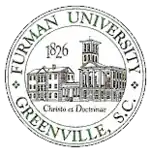 | |
Former names | Furman Academy and Theological Institution (1826–1829) Furman Theological Institution (1829–1834) Furman Institution (1837–1851) |
|---|---|
| Motto | Christo et Doctrinae |
Motto in English | For Christ and Learning |
| Type | Private liberal arts university |
| Established | 1826 |
Academic affiliations | |
| Endowment | $812.3 million (2022)[1] (Beneficiary of the Duke Endowment, 1924) |
| President | Elizabeth Davis |
Academic staff | 321 [2] |
| Undergraduates | 2,443 (Fall 2022)[2] |
| Postgraduates | 160 [2] |
| Location | , U.S. |
| Campus | Suburban, 750 acres (304 ha) |
| Colors | Purple & white[A 1] |
| Nickname | Paladins |
| Mascot | Paladin |
| Website | www |
Furman University is a private liberal arts university in Greenville, South Carolina. Founded in 1826 and named after Baptist pastor Richard Furman,[A 2] Furman University is the oldest private institution of higher learning in South Carolina. It became a secular university in 1992, while keeping Christo et Doctrinae (For Christ and Learning) as its motto. As of Fall 2021, it enrolls approximately 2,300 undergraduate students and 150 graduate students on its 750-acre (304 ha) campus.[2]
History
Beginnings (19th century)
Furman Academy and Theological Institution was established by the South Carolina Baptist Convention and incorporated in December 1825 in Edgefield. With 10 students, it held its first classes January 15, 1828;[D 1] although another source says it opened in January 1827.[3] Through 1850, average enrollment was 10 students, and it constantly tottered on the edge of insolvency. From 1829 to 1834, it operated in the High Hills of the Santee (now Stateburg, South Carolina). Furman closed from 1834 to 1837.[3] When the school reopened, at the urging of the Reverend Jonathan Davis, chairman of the Board of Agents, the school moved to his native Fairfield County, near Winnsboro.
In 1850, the state legislature chartered Furman University.[3] It was not until 1851 that South Carolina Baptists were able to raise the necessary funds for the removal of the school to Greenville, South Carolina.
The university closed from 1861 to 1866, when "most students and several faculty members enlisted in the Confederate forces."[3]
The Furman Institution Faculty Residence serves as a visible reminder of the early history of Furman University and its brief establishment in Fairfield County.[D 2][D 3]
Growth and expansion (20th century)
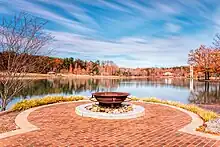
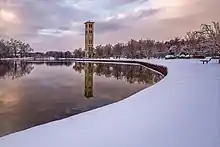
The first school building from the downtown Greenville campus was transported to the current campus, where it still stands. In 1933, students from the Greenville Women's College began attending classes with Furman students. Shortly thereafter, the two schools merged to form the present institution.
In 1924, Furman was named one of four collegiate beneficiaries of the Duke Endowment. Through 2007, Furman has received $110 million from the endowment, which is now one of the nation's largest philanthropic foundations. Three other colleges—Duke, Davidson and Johnson C. Smith—also receive annual support and special grants from the endowment.[A 3]
In 1954, Brown v. Board of Education found the "separate but equal" policy to be unconstitutional, starting the lengthy process of desegregating public schools. As of that date, Furman, like most Southern colleges, did not accept African Americans as students. Some Furman students began to press for change.[B 1] In 1955, some students wrote short stories and poems in The Echo, a student literary magazine, in support of integration; school administrators destroyed all 1,500 printed copies.[B 1] In 1953, Furman began construction on its new campus,[A 4] five miles (8 km) north of downtown Greenville. Classes on the new campus began in 1958.
By 1963, enough faculty were siding with the students over racial desegregation that Furman's board of trustees voted to admit Black students. Action on the trustees' decision was postponed and it was later overturned by South Carolina's Baptist Convention; desegregated admission was not implemented at Furman until its incoming president, Gordon W. Blackwell, a past president of Florida State University, made it a condition of his acceptance of the new position.[B 1] In 1965, Joe Vaughn was the first black undergraduate to enroll.[B 1]
In 1992, the South Carolina Baptist Convention ended its affiliation with Furman.[A 5] Furman's "heritage is rooted in the non-creedal, free church Baptist tradition which has always valued particular religious commitments while insisting not only on the freedom of the individual to believe as he or she sees fit but also on respect for a diversity of religious perspectives, including the perspective of the non-religious person."[A 6]
Recent history (21st century)
The 2010s were transformative years for Furman through fundraising, resulting in new buildings, programs, and scholarships. The Because Furman Matters campaign began in 2004 and ended in 2013. The campaign was described as "the largest fundraising campaign ever among private colleges in South Carolina, and is also among the largest undertaken by any of the nation's liberal arts colleges.".[A 7] It exceeded its objective of raising $400 million, of which 62% went to the endowment (which was valued at $380 million when the campaign started and increased to $623 million when it ended) and 17% went to building projects. Several such buildings were supported by successful graduates from the university via naming gifts. In 2012, a new $6.4 million facility was built for continuing education.[D 4] The Herring Center for Continuing Education was supported by Sarah and Gordon Herring, a leader in the television industry who served on committees with HBO and was one of the founders of the Weather Channel. In 2013, the student center went through a $7.75 million expansion and renovation. The alumnus and businessman David Trone, together with his wife June, participated through a $3.5 million gift resulting in the center being named the Trone Student Center.[A 8]
While students and visitors are most likely to notice newer and renovated buildings, or experience campus wide programs, changes have also been more subtle in several other aspects. For instance, alumni have continued to fuel the development of scholarship funds for specific purposes. In 2017, a $2.2 million bequest from the late Mary Frances Edwards Garrett was dedicated to a fund for students seeking teaching and ministerial professions.[A 9]
Task Force on Slavery and Justice
In October 2018, a Task Force on Slavery and Justice, set up by Provost George Shields, issued a report, Seeking Abraham, making recommendations "to acknowledge the role slavery and racism had in the school’s history."[4] The task force is a response to the article, "Slavery, Memory and Reconciliation: What is the Furman Legacy?", published in October 2016 in the university newspaper, pointing out that Richard Furman, the university's namesake, and even more so his son James Clement Furman, Furman's first president, were not only slave owners but active defenders of slavery. "Abraham" is a reference to Abraham Sims, a slave at the house of James Furman.
The task force issued 19 recommendations, which were unanimously accepted by Furman's board of trustees.[5] James C. Furman Hall will be renamed Furman Hall, and a statue will be erected to honor Joseph Vaughn, "the first Black student to attend the school".[4] A tour of the university, "Seeking Abraham", looks at campus "from the perspective of the native people who first called the campus home, the enslaved and laborers, the women who pushed against the Furmans' views, the eventual students and faculty who pushed desegregation forward, and the Baptists who eventually broke with their own Convention.... Much of this history is 'hidden' in the current landscape."[6]
Organization and administration
| University presidents | |
|---|---|
| President | Years |
|
| |
| James Clement Furman | 1859–1879 |
| Charles Manly | 1881–1897 |
| Andrew Philip Montague | 1897–1902 |
| Charles Hallette Judson | 1902–1903 (acting) |
| Edwin McNeill Poteat | 1903–1918 |
| Sidney Ernest Bradshaw | 1918–1919 (acting) |
| William Joseph McGlothlin | 1919–1933 |
| Bennette Eugene Geer | 1933–1938 |
| Robert Norman Daniel | 1938 (acting) |
| John Laney Plyler | 1939–1964 |
| Gordon Williams Blackwell | 1965–1976 |
| John Edwin Johns | 1976–1994 |
| David Emory Shi | 1994–2010 |
| Rodney Alan Smolla | 2010–2013 |
| Carl F. Kohrt | 2013–2014 (interim) |
| Elizabeth Davis | 2014–present |
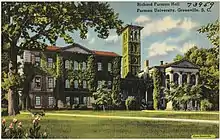
Leadership and guidance to the university is provided by a board of trustees, whose 36 members meet at least three times per academic year and are elected for three-year terms. Former board members may be designated as 'Trustees Emeriti'. These include former Governor and U.S. secretary of education Richard Riley.[A 10] As of 2023, current board members include David Trone, U.S. representative for Maryland's 6th congressional district, and William Byrd Traxler Jr., Senior Judge of the United States Court of Appeals.[A 11] Board members also come from private companies[A 11]
Under the governance of the board of trustees, Furman is led by a President. Elizabeth Davis became Furman's president on July 1, 2014. She is the 12th president of the institution, or 16th when also counting interim presidents. As of 2023 eleven senior administrators manage academic and administrative departments. These administrators are composed of a provost, a dean of faculty, and nine other members.[A 12]
Academics

Furman offers majors and programs in 42 subjects. All students must complete general education requirements as part of the liberal arts curriculum. The general education requirements include mind and body wellness, textual analysis, two natural sciences, math/formal reasoning, two empirical studies of human behavior, history, ultimate question, foreign language, and world culture. Furman is not divided into colleges, but includes centers and four institutes. Furman's four institutes are the Shi Institute for Sustainable Communities, the Richard W. Riley Institute, the Institute for the Advancement of Community Health, and the Hill Institute for Innovation and Entrepreneurship. Its most popular undergraduate majors, by 2021 graduates, were:[7]
- Exercise Science and Kinesiology (58)
- Biology/Biological Sciences (51)
- Speech Communication and Rhetoric (48)
- Political Science and Government (47)
- Business Administration and Management (46)
- Psychology (41)
Furman has produced 20 Truman Scholars,[8] as well as several Rhodes scholars and recipients of Goldwater, Fulbright and National Science Foundation Awards.[9]
Reputation and rankings
| Academic rankings | |
|---|---|
| Liberal arts colleges | |
| U.S. News & World Report[10] | 46 (tie) of 185 |
| Washington Monthly[11] | 87 of 199 |
| National | |
| Forbes[12] | 167 of 498 |
| THE / WSJ[13] | 233 of 400 |
In 2023, Furman was ranked 46th out of 185 in U.S. News & World Report's 2023 National Liberal Arts Colleges rankings[14]
As of 2023, Furman is also featured in The Princeton Review's "Best 378 Colleges" list and was named as one of 143 "Best Southeastern Colleges"[15] The Princeton Review also ranked Furman in 5th place on its list of universities committed to national service in 2016.[16]
In 2019, Furman University was ranked 21st in a list of 25 colleges and universities in the South by Forbes,[17][18].
Furman ranked 23rd among all liberal arts colleges in number of graduates who went on to receive PhDs from 1990 to 1995.[19] Furman ranked 76th among all universities in the nation of graduates that went on to receive PhDs from 2008 to 2017.[20]
Campus
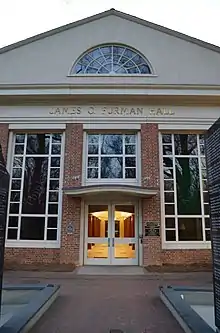
Furman University's campus is located at the foothills of the Blue Ridge Mountains in the upstate region of South Carolina. A 40-acre (16.2 ha) lake is a highlight of the 750-acre (304 ha) wooded campus. Paris Mountain State Park overlooks the lake and campus. Most buildings are of Georgian-style architecture. Many academic buildings and student residences stand around the lake, including the Bell Tower, which figures highly in school insignias and is a replica of the tower that once existed on the men's campus in downtown Greenville.
Furman's campus has been named one of the most beautiful campuses in the nation.[21][22][23] In 2016, USA Today named Furman's campus as the 4th most beautiful campus out of 10.[24] Times Higher Education named it ninth out of the ten most beautiful campuses in the nation in 2017.[23] In 2019, Travel + Leisure listed Furman as 23rd out of 25 of the most beautiful college campuses in the United States.[25]
Timmons Arena
Timmons Arena is a 4,000-seat multi-purpose arena in Greenville, in the U.S. state of South Carolina.[D 5] It was built in 1997 at a cost of $10.9 million by Stanmar, Inc., and is home to the Furman University Paladins basketball team since its opening on December 30, 1997.[A 13][D 6]
Housing
On the north side of the lake are four Greenbelt housing cabins and the Cliffs Cottage.[A 14] This 34,000-square-foot (3,200 m2) "green" building designed by Scott Johnston is solar-powered using two panels, and features geothermal heating.[B 2][D 7] Cliffs Cottage was the first sustainable showcase home for Southern Living magazine, which featured it in the article Our Most Innovative House Ever, detailing how to create a house that requires less energy and generates power.[D 7] The cottage now serves as home for the Shi Institute for Sustainable Communities.
The North Village Apartments are located on the north side of the Cliffs Cottage. The Vinings is an apartment complex next to campus owned by the university. There are two other residence complexes, Clark Murphy Housing Complex and South Housing. The campus also includes an Asian Garden, the centerpiece of which is the Place of Peace, a Buddhist temple moved to the site from Japan. A replica of the cabin that Henry David Thoreau inhabited while writing On Walden Pond is located on the west side of the lake.[A 15]
 James B. Duke Library
James B. Duke Library John E. Johns Hall
John E. Johns Hall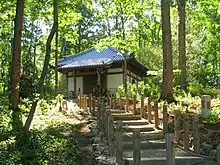
Environmental sustainability
Furman works to conserve, reduce, and recycle on campus, has constructed green buildings and provided students with alternative transportation. Furman has a farm on campus. The Furman Farm is a quarter-acre garden located beside the Cliffs Cottage and the Furman Lake. A wide variety of produce is grown throughout the year using sustainable agricultural practices such as crop rotations, composting, drip lines, natural fertilizers, and integrated pest management.[A 16] Furman also has installed a 6-acre solar farm with a 743 kW solar photovoltaic (PV) array near the campus entrance. The university hopes to achieve carbon neutrality by 2026.[A 17][26]
The Princeton Review featured Furman in its 2023 list of 455 Green Colleges; it received a green rating of 90, within a possible range of 60-99 .[27] In. 2015, the Sierra Club included Furman in its list of the top 50 eco-friendly universities in America.[28] Furman received a grade of "A−" from the Sustainable Endowments Institute on its College Sustainability Report Card in 2011 along with 52 other institutions.[29] Furman takes part in the voluntary self-reporting Sustainability Tracking Assessment Ratings System (STARS), in which it received a gold rating in 2021.[30]
| Percentage | |
|---|---|
| White | 77.0 |
| African American | 7.0 |
| Hispanic | 6.0 |
| Asian | 3.0 |
| Non-resident | 3.0 |
| Multiracial or other | 3.0 |
Athletics
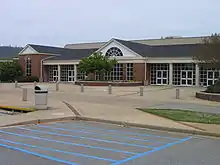
Furman competes in NCAA Division I athletics, and at the FCS (Football Championship Subdivision) level in football. Furman fields seven men's teams and nine women's teams, as well as 16 club sports and many intramural teams.[A 18] The university is a member of the Southern Conference.
In 2007, Furman was ranked 82nd out of 200 in Sports Illustrated's list of America's Best Sports Colleges.[D 8]
In 2018, Furman was placed 73rd out of 291 colleges in the NACDA Directors' Cup Division I Final Standings, highest among Southern Conference members.[32] In the 2019–2020 season, Furman finished in 32nd place our of 157 institutions in the NACDA Director's Cup Final Fall Standings.[33]
The team nickname, the Paladins, was first used by a Greenville, South Carolina, sportswriter in the 1930s. For many years the name "Paladins" just referred to Furman's basketball team. Until 1961 the school's baseball teams were known as the "Hornets" and the football teams as the "Hurricanes". On September 15, of that year, the student body voted to make "Paladins" the official nickname of all of the university's intercollegiate athletic teams.
Notable people
Notable alumni
- Charles H Townes, physicist, 1964 Nobel Prize Winner in Physics
- John B. Watson, psychologist, founder of Behaviorism
- Richard Riley, United States Secretary of Education under President Bill Clinton
- Herman W. Lay, founder of Frito-Lay potato chips
- Eleanor Beardsley, bilingual journalist and foreign correspondent for National Public Radio based in Paris
- Amy Grant, contemporary Christian/pop artist and 6-time Grammy Award winner
- John Michael McDonnell, Admiral, former Director of the National Security Agency, and former Director of National Intelligence in President George W. Bush's administration
- Brad Cox, computer scientist, creator of the Objective-C programming language
- Keith Lockhart, conductor, music director of the Boston Pops Orchestra, and Principal Conductor of the BBC Concert Orchestra
- Thomas T. Goldsmith Jr., television pioneer, the co-inventor of the first arcade game to use a cathode-ray tube
- Alexander Stubb, politician, former prime minister of Finland
- Judy Clarke, criminal defense attorney who has represented high-profile defendants
- Robert Blocker, dean of the Yale School of Music
- John F. Mulholland Jr., former CIA associate director
- Mark Sanford, politician, former Governor of South Carolina and former U.S. Representative for South Carolina's 1st district
- Brad Faxon, retired professional golfer, won eight PGA Tour events
- Tomiko Brown-Nagin, legal historian, former dean at Harvard University
- Clint Dempsey, retired professional soccer player
- Beth Daniel, 33 LPGA Tour events winner and member of the World Golf Hall of Fame
- Sam Wyche, former head coach for the Cincinnati Bengals and quarterbacks coach for the San Francisco 49ers
- Robert G. Owens Jr., Major general, U.S. Marine Corps and flying ace
- Victoria Jackson, actress and comedian, former cast member of NBC Saturday Night Live
- Ben Browder, actor, writer and director
- Bear Rinehart, singer, songwriter, lead singer of band Needtobreathe
- David C. Garrett Jr., businessman, former CEO of Delta Air Lines
- Allie Beth Stuckey, podcast host, blogger, and conservative commentator.
- Xavier Woods, WWE superstar and YouTube personality
- Julie McElrath, world-leading HIV immunology and vaccine researcher
- Jay Jackson, Major League Baseball pitcher[34]
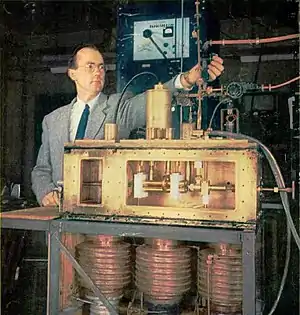 Charles H. Townes received his BS in physics from Furman. A Nobel Laureate in Physics, he invented the maser and laser.
Charles H. Townes received his BS in physics from Furman. A Nobel Laureate in Physics, he invented the maser and laser. Mark Sanford received his BA in business from Furman. He was the Governor of South Carolina.
Mark Sanford received his BA in business from Furman. He was the Governor of South Carolina.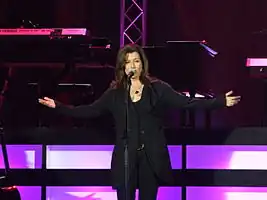 Amy Grant won six Grammy Awards. Her first ticketed concert took place during her first year at Furman.
Amy Grant won six Grammy Awards. Her first ticketed concert took place during her first year at Furman.
Notable faculty
- Jay Bocook, composer and arranger, whose work was heard during the 1984 Olympic Games Opening Ceremonies in Los Angeles
- Thomas T. Goldsmith Jr., physicist, who helped pioneer the invention of color television, and inventor of the first video game
- Richard Riley, politician, Governor of South Carolina and sixth U.S. Secretary of Education
- Mark Kilstofte, musician, winner of the American Academy in Rome's Rome Prize for 2002–2003[D 9]
- Charles H Townes, physicist, 1964 Nobel Prize winner in Physics
- Alan Axelrod, historian and author of business and management books
- Brent Nelsen, political scientist and professor
- Anthony Ensolen, writer and translator of classical works
- Edvard Tchivzhel, conductor and music director
- William Preucil, composer, violinist and Grammy Award winner
See also
References
- Furman University Website (A)
- ↑ "Logo Use". Furman.edu. 2012-07-22. Retrieved 2015-07-18.
- ↑ "Furman University History". Furman University. Archived from the original on 2010-09-10. Retrieved 2010-11-29.
- ↑ "Duke Endowment: Partners in Progress". Archived from the original on 2009-10-12. Retrieved 2014-09-05.
- ↑ Furman University: Our History. http://www.furman.edu/about-furman/history/
- ↑ "History 21: Religious Controversies: Split with the SBC". library.furman.edu. Archived from the original on 2010-06-14.
- ↑ "Positioning Statement". Furman University. Archived from the original on 2015-10-18. Retrieved 2014-09-05.
- ↑ Moore, Vince (2014-01-08). ""Because Furman Matters" campaign reaches successful conclusion". Retrieved 2018-07-07.
- ↑ Roberts, John (September 20, 2013). "Furman dedicates Trone Student Center". Furman University. Archived from the original on 2020-11-30. Retrieved 2018-07-07.
- ↑ Moore, Vince (2017-05-24). "Alum Mary Frances Edwards Garrett bequests $2.2 million gift to Furman". Furman University. Retrieved 2018-07-07.
- ↑ Trustees Emeriti. http://www.furman.edu/about-furman/university-leadership/board-of-trustees/trustees-emeriti/ Archived 2018-10-13 at the Wayback Machine
- 1 2 Board Members. http://www.furman.edu/about-furman/university-leadership/board-of-trustees/board-members/.
- ↑ Senior Administrators. http://www.furman.edu/about-furman/university-leadership/senior-administrators/
- ↑ "Furman To Begin Play In Timmons Arena Tuesday Versus Northeastern Illinois". Furman University. December 29, 1997. Retrieved April 17, 2014.
- ↑ "Engaged Living's Greenbelt Community". Furman.edu. Archived from the original on 2018-10-13. Retrieved 2010-01-05.
- ↑ "The Simple Cabin by the Lake". Furman.edu. Archived from the original on 2013-08-10. Retrieved 2010-01-05.
- ↑ "The Furman Farm". Archived from the original on 2020-02-13. Retrieved 2016-06-01.
- ↑ "Our Vision, Furman Sustainability". Archived from the original on 2020-02-13. Retrieved 2016-06-01.
- ↑ "About Furman | Furman University". Furman.edu. 2012-07-22. Archived from the original on 2015-10-18. Retrieved 2015-10-15.
- Newspapers (B)
- 1 2 3 4 Cary, Nathaniel (September 5, 2014). "Furman reflects on desegregation". The Greenville News. Retrieved 2014-09-05.
- ↑ "Kaplan: The New On-Campus Environmentalism". Newsweek. 17 August 2008. Retrieved 2018-03-14.
- Ranking websites (C)
- ↑ As of June 28, 2022.U.S. and Canadian Institutions Listed by Fiscal Year 2022 Endowment Market Value and Change in Endowment Market Value from FY21 to FY22 (Report). National Association of College and University Business Officers and TIAA. February 19, 2022. Retrieved June 28, 2023.
- 1 2 3 4 "College Navigator - Furman University".
- 1 2 3 4 Henderson, A. Scott (2016). "Furman University". South Carolina Encyclopedia.
- 1 2 Gilreath, Ariel (May 22, 2019). "Furman University to rename James C. Furman Hall, erect statue of first black student". Greenville Journal. Archived from the original on May 23, 2019. Retrieved May 24, 2019.
- ↑ Davis, Elizabeth (May 22, 2019). "President announces Board of Trustees resolution – May 2019". Furman University.
- ↑ Seeking Abraham Project. "Seeking Abraham at Furman University". Retrieved May 24, 2019.
- ↑ "Furman University". nces.ed.gov. U.S. Dept of Education. Retrieved February 27, 2023.
- ↑ "Search Our Scholars- The Harry Truman Scholarship". Truman.gov.
- ↑ Tollison, Courtney (2004). Furman University. Arcadia. p. 63. ISBN 9780738517254.
- ↑ "Best Colleges 2024: National Liberal Arts Colleges". U.S. News & World Report. Retrieved September 20, 2023.
- ↑ "2023 Liberal Arts Rankings". Washington Monthly. Retrieved September 25, 2023.
- ↑ "Forbes America's Top Colleges List 2023". Forbes. Retrieved September 22, 2023.
- ↑ "Wall Street Journal/Times Higher Education College Rankings 2022". The Wall Street Journal/Times Higher Education. Retrieved July 26, 2022.
- ↑ US News, Furman University.https://www.usnews.com/best-colleges/furman-university-3434/overall-rankings
- ↑ "The Princeton Review- Furman University". Princeton Review.
- ↑ "Best colleges for students who want to change the world". Business Insider.
- ↑ "Top 25 Colleges In The South 2019". Forbes.
- ↑ "America's Top Colleges 2022". Forbes.
- ↑ "Furman Tops Among Southern Liberal Arts Colleges For Grads Earning Ph.D. Degrees". Collegenews.org. Archived from the original on 2006-10-05.
- ↑ "Baccalaureate Origins of Doctorate Recipients 2008-2017. Top 100 Institutions" (PDF). Swarthmore.edu. Archived (PDF) from the original on 2020-11-01.
- ↑ "40 of the Most Beautiful College Campuses in the World". House Beautiful (published 2019). 3 May 2019.
- ↑ "Top Of The Most Beautiful Universities In The World". e-Architect. 2020.
- 1 2 "The 10 most beautiful universities in the US". Times Higher Education. 2017.
- ↑ "USA Today Best Beautiful College Campus (2016)". 10Best. 2016.
- ↑ "America's Most Beautiful College Campuses". Travel + Leisure. Retrieved 26 January 2015.
- ↑ Relations, Vince Moore, Director, News & Media; Relations, Vince Moore, Director, News & Media (2017-04-30). "Furman's solar farm is online". Furman News. Retrieved 2020-10-25.
{{cite web}}: CS1 maint: multiple names: authors list (link) - ↑ "Green Colleges". Princeton Review.
- ↑ "America's Greenest Universities". Sierra Club. 26 March 2020.
- ↑ "2011 College Sustainability Report Card". Archived from the original on 2021-04-14. Retrieved 2016-06-01.
- ↑ Furman University, Sustainability: Our Vision. http://www2.furman.edu/sites/sustainability/ourvision/Pages/OurCommitment.aspx Archived 2020-02-13 at the Wayback Machine
- ↑ "Furman University". College Navigator. Retrieved May 24, 2023.
- ↑ "2018 Learfield Directors' Cup Division I Final Standings" (PDF). Nacda. Archived from the original (PDF) on July 2, 2021.
- ↑ "2019-20 Learfield IMG College Directors' Cup Division I Final Fall Standings" (PDF). NACDA.
- ↑ "Jay Jackson". ESPN. Retrieved December 13, 2021.
- Other sources (D)
- ↑ "Furman University" in The New Encyclopedia of Southern Culture, (Volume 17: Education), Clarence L. Mohr, ed. (UNC Press Books, 2011) p221
- ↑ unknown (n.d.). "Furman Institution Faculty Residence" (PDF). National Register of Historic Places - Nomination and Inventory. Retrieved 5 July 2012.
- ↑ "Furman Institution Faculty Residence, Fairfield County (int. of S.C. Hwy. 213 & S.C. Sec. Rds. 70 & 23, Winnsboro vicinity)". National Register Properties in South Carolina. South Carolina Department of Archives and History. Retrieved 5 July 2012.
- ↑ "Furman Univ. opens new $6.4M facility". Fox Carolina. Archived from the original on 2018-07-24. Retrieved 2018-07-07.
- ↑ Official Site; Timmons Arena
- ↑ Timmons Arena - FurmanPaladins.com
- 1 2 "Our Most Innovative House Ever". Southern Living. Archived from the original on 2021-03-15. Retrieved 2018-03-14.
- ↑ "America's Best Sports Colleges". Sports Illustrated. Archived from the original on 2007-08-22. Retrieved 26 January 2015.
- ↑ Archived February 14, 2006, at the Wayback Machine
Further reading
- Bainbridge, Judith Townsend. Academy and College: The History of the Woman's College of Furman University (Mercer University Press, 2001) online.
- McGlothlin, William Joseph. Baptist beginnings in education: A history of Furman University ( Sunday School Board of the Southern Baptist Convention, 1926) online.
- Michel, Gregg L. "It Even Happened Here: Student Activism at Furman University, 1967-1970." South Carolina Historical Magazine 109.1 (2008): 38-57. online
- Neumann, Brian. “ 'We cannot expect to rebuild the world overnight’: race, reform, and reaction at Furman University, 1933–1955.” South Carolina Historical Magazine 116#2 (2015), pp. 122–41. online
- Seeking Abraham. A Report of Furman University's Task Force on Slavery and Justice (PDF). Furman University. 2018.
- Tollison, Courtney L. "In pursuit of excellence: Desegregation and Southern Baptist politics at Furman University." History of Higher Education Annual: 2003-2004 (Routledge, 2017) pp. 23-48.
- Tollison, Courtney L. Furman University (Arcadia Publishing, 2004) online.
External links
34°55′33″N 82°26′8″W / 34.92583°N 82.43556°W